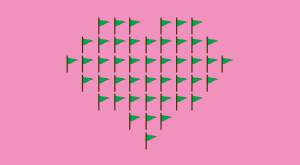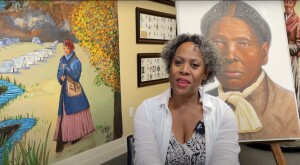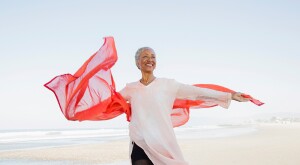Do you have a practice that helps you center both body and spirit? Share your thoughts in the comments below.
One of my favorite Bible verses reads: “I praise you because I am fearfully and wonderfully made; your works are wonderful, I know that full well.” From the acne of adolescence to the belly bulge of medically induced menopause, I have clung to this piece of Scripture like David clinging to his slingshot as I try to slay the Goliath-size giant of body insecurity.
As a church-going girl, I thought I’d find the secret to self-love in sermons and hymns. But I was wrong. Instead, I would find the answer in the “Sacred Black Feminine” – a concept I wouldn’t learn about until my 40s. This quest to see God in a completely new way led me away from the church, only to bring me back again. Most importantly, this journey brought me home to myself.
Created In God’s Image?
“Fearfully and wonderfully made” — these words from Psalm 139:14 are beautiful, but I didn’t truly believe them because I didn’t observe that I was created in God’s image.
Thanks to the media, as a little girl, I pictured God as a white man with white hair sitting on a white cloud. I imagined him writing in a white book each time I said a bad word or took change from my Lenten folder for a trip to the candy lady or the ice cream truck.
The same church that through its liturgical dance ministry showed me that my body could be used as an instrument of worship and praise also made me feel my body was a source of shame. Women and girls were often admonished to cover up as much of their skin as possible lest they tempt the boys and men of the church into sin.
As I got older, as I started studying Scripture even more, I started to wonder if the God of the Bible could be trusted. The story of Lot in Genesis 19 traumatized me as I read of Lot offering up his daughters to be raped and sat through sermons in which this action was praised as shrewd. And how could I feel safe with a God who would turn my body into a pillar of salt just for wanting one final look at the place I called home?
Also — what’s up with Proverbs 31? This chapter of the Bible describes what it means to be a virtuous woman, but reads more like a recipe for burnout. I’ve been giving that passage of Scripture the side-eye since I was a kid. In fact, I once got kicked out of vacation bible school for asking too many questions about it. Questions like, “What’s the husband doing while this woman is doing all of this?” The more I studied the Bible — the same Bible that I once placed under my pillow to ward off nightmares as I slept— the more unsafe I felt in my Black woman body.
At church I faced similar confusing contradictions. The same church that through its liturgical dance ministry showed me that my body could be used as an instrument of worship and praise also made me feel my body was a source of shame. Women and girls were often admonished to cover up as much of their skin as possible lest they tempt the boys and men of the church into sin.
The Sacred Black Feminine
Body acceptance is an inside job. And by the time I was a grown woman I knew the white man sky god of my childhood couldn’t get the job done. And to be honest, I didn’t feel like Black Jesus could handle this either.
This was a job for the Sacred Black Feminine.
In her book God Is a Black Woman, Christena Cleveland defines the Sacred Black Feminine as “a divine being who stands with and for Black women because She Herself is a Black woman.” In her book, Cleveland chronicles her pilgrimage to encounter several figures of the Black Madonna throughout Europe, figures she considers to be images of the Sacred Black Feminine. But this book is about body acceptance too as Cleveland contrasts her struggles with disordered eating with the body positivity she feels when staring at images of the Black Madonna that “proudly take up space.”
In the book, Cleveland details a daily body gratitude exercise that I immediately tried. After getting out of the shower I stand in a full-length mirror to examine my body, and I verbally thank my body for all it is doing to keep me alive. I honor my feet and my legs for carrying me through this life. I get cocky and tell the mirror my face card is never declined. I think of the Black Madonna in Mende, France known as Our Lady of the Fountain because of the water that flowed from her loins. Cleveland calls her “She Whose Thick Thighs Save Lives” and as I stare at my own body, I proudly take on that name too.
As I gently caress the scars around my left breast, I yell out to cancer 'You tried it!' and then boldly quote Genesis 50:20, declaring, 'You intended to harm me, but God intended it for good to accomplish what is now being done.'
I lovingly grip the extra flesh that menopause has wrapped around my waist. I thank my stomach for turning my food into fuel and my gut for never steering me off track. And as I gently caress the scars around my left breast, I yell out to cancer “You tried it!” and then boldly quote Genesis 50:20, declaring, “You intended to harm me, but God intended it for good to accomplish what is now being done.”
Body acceptance, however, is a journey, not a destination. And for me, body acceptance and liberated faith go hand-in-hand. It’s all a work in progress, work that I’ve aided with other books like The Dance of the Dissident Daughter by Sue Monk Kidd and The Day God Saw Me as Black by D. Danyelle Thomas and by joining a Methodist church shepherded by a female pastor, a church that prays to “Father/Mother God.”
Yet I have not turned my back on the Bible. That holy book is part of this process too. In fact, it is through the Sacred Black Feminine that I am finding empowerment, joy and peace in the faith of my youth. I even proudly sport a sweatshirt with words from Proverbs 31 because when I look in the mirror at my Black woman body, I do see “strength and dignity.”
And as I read about the traits (and to-do list) of a virtuous woman, I no longer feel overwhelmed because I am reminded of words Thomas writes in The Day God Saw Me as Black: “Choosing myself as worthy is the most virtuous thing I will ever do.”
Eventually, thanks to Cleveland’s work and body gratitude exercise, as well as the words of Kidd, Thomas, and other progressive theologians, I began to see my body as my best friend, not an enemy to be conquered, corrected, or covered up. And one day I saw my body as a physical representation of the Sacred Black Feminine. I finally believed I was created in the image of God. I finally believed that I was fearfully and wonderfully made.
Do you have a practice that helps you center both body and spirit? Share your thoughts in the comments below.











